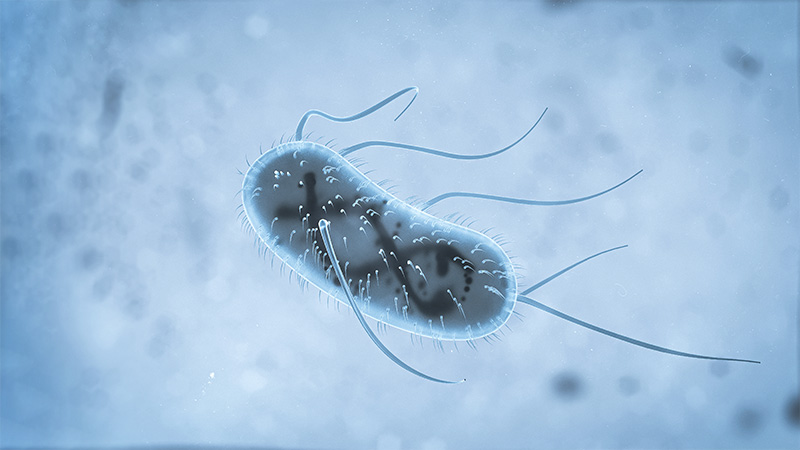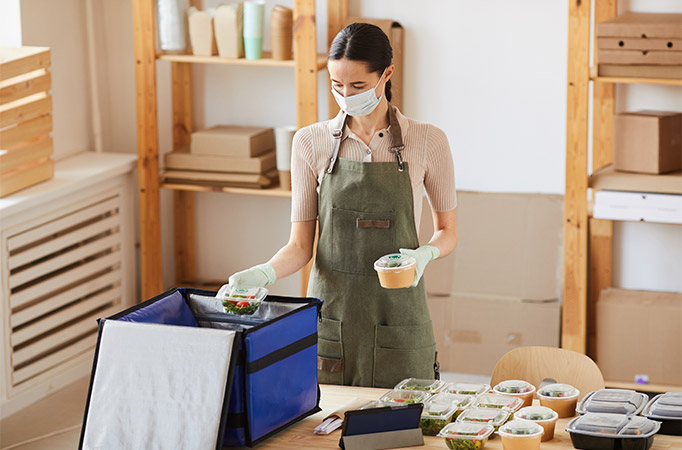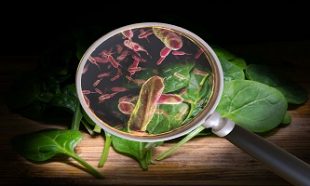Food Hygiene & Safety
What is the Most Common Type of Food Contamination – Physical Contamination
Imagine you are in your favourite restaurant having your go-to food, a burger. Just when you give the first bite, an unexpected incident occurs. You find hair in the patty! This is utterly disgusting, right?
When incidents like this happen, it means that the food establishment is not concerned about food safety as they are serving contaminated food. And, what is food contamination? Well, you need to give a read to the blog to know the answer!
Learn about the most common types of food contamination, including physical contamination of food, its effects and the ways to prevent physical contamination of food from this blog.
Table of Content
- What is Food Contamination?
- Different Types of Contamination of Food
- What Causes Physical Contamination of Food?
- What might be the Effects of Physical Contamination in Food Business?
- How to Detect Physical Contamination of Food?
- How to Prevent Physical Contamination of Food?
- How to Prevent the Other Types of Food Contamination?
- Conclusion:
- What to Read Next:
What is Food Contamination?
Food contamination refers to the degeneration of spoiled foods because of microorganisms such as bacteria, parasites, or toxic substances, making them unfit for consumption.
As per BBC, “Every year campylobacter (a type of bacteria) is linked to about 460,000 poisoning cases, 22,000 hospital admissions and 110 deaths.” This statement clearly indicates how food contamination can be life threatening.
Contamination might occur during food handling or at any stage of the manufacturing process. However, the major vulnerabilities lie in the production and supply chain.
Different Types of Contamination of Food
Whether you have a food business or you are into food handling, you should be aware of the four main types of food contamination. They are-
- Physical
- Chemical
- Microbial and
- Allergenic contamination
These four types of contamination present a risk for all kinds of food. Therefore, all the food handlers must ensure that the food prepared on their premises is free from these contaminants and is safe for consumption.
Check out our other blog, “Food Hygiene Rating Scheme – Top 10 Tips to Get It [2023]”
Physical Contamination
When food gets contaminated by any foreign object, physical contamination of food occurs. Food can get physically contaminated at any stage of food delivery and preparation. It can cause serious harm to the consumer, including choking or broken teeth. Furthermore, physical contaminants might carry harmful bacteria, posing an even greater risk.
The most common physical contaminants found in food are glass, plastic, metals, stones, jewellery, fingernails and hair. Physical contamination of food may also occur from the environment, including the building and the equipment you are using, for instance, flakes of paint, plaster, and screw fixings.
Physical contamination also occurs because of issues with packaging, such as staples, polythene, and cardboard. Some physical contamination is found to occur naturally, like insects entering vegetables and fruits or bones in boneless fish.
Chemical Contamination
When food becomes contaminated by some sort of natural or artificial chemical substances, it is called chemical contamination. This type of contaminants are particularly threatening and the consequence of anyone consuming it could be fatal. The symptom of chemical contamination can be mild gastroenteritis; however, chemicals in food can be lethal in some cases.
Contamination may occur from chemicals that are frequently used in the kitchen for cleaning and disinfection and sprayed close to uncovered food. It can also happen when you prepare food on a surface that still has chemical residue.
Food can be contaminated by chemicals even before it reaches your kitchen! When fertilisers and pesticides are sprayed near food when it is growing, chemical contamination occurs.
Microbial Contamination
Microbial contamination is basically the existence of harmful pathogens in food like microorganisms, viruses, bacteria, fungi, mould and toxins. This type of contamination is the leading cause of food-borne diseases and food poisoning.
The most common food-borne diseases include salmonella, listeria, e.coli, and campylobacter and symptoms can range from mild gastroenteritis to long-term diseases.
Microbial contamination can occur due to-
- Storing and preparing raw foods close to ready to eat food
- Undercooked chicken that gives rise to campylobacter
- The salmonella that lives in animal intestines during the rearing and slaughtering of animals
- The toxic-producing organisms that reside inside the fish and shellfish when they eat them
Allergenic Contamination
Food causing an allergic reaction comes into contact with another food, and allergenic contamination happens. For instance, if the same knife is used to cut normal bread and gluten-free bread or if pasta is stored in a tub that contained peanuts previously.
14 allergens should be marked and labelled for food safety. The allergens include eggs, milk and dairy, nuts, peanuts, crustaceans, molluscs, cereals containing gluten, lupin, celery, sesame seeds, mustard, soya, and sulphur dioxide.
Besides, check out our other blog, “What is the Temperature Danger Zone for Food? Chart Included.”
Cross-Contamination
When pathogens are transferred from a surface, object or person to food, cross-contamination occurs. Dirty kitchen clothes, unwashed utensils, pests, and raw food storage can lead to cross-contamination. Also, sneezing, coughing or even touching face or hair before handling food can cause cross-contamination.
 Are you looking for a food hygiene course?
Are you looking for a food hygiene course?
What is the Most Common Type of Food Contamination?
Physical contamination is one of the most common among the four types of food contamination. Following strict, high-standard food hygiene measures is the best method to avoid this form of contamination. This blog mainly focuses on the physical contamination of food.
What Causes Physical Contamination of Food?
Food can get contaminated for various reasons. It could be because the person who prepared or served the food has accidentally dropped something into the dish, a piece of packaging left behind or due to the use of inappropriate cooking and serving utensils.
The occurrence of physical contamination might be an unfortunate incident. For example, a piece of hair might fall from the server into the dish on its way from the kitchen to the customer’s table. It could also be due to the unawareness of the food business owners who prepare food in an unhygienic environment.
Besides, certain practices can increase the risk of physical contamination of food, such as-
- When food is left uncovered in the open air for a long time
- When pans are left on the stove without a lid during cooking
- If food is prepared or packaged in an unclean and unhygienic environment
- When staff are not adequately trained or careless with their food preparation
- If food handlers and kitchen staff wear jewellery, false nails, eyelashes, or pale coloured plasters
- When broken utensils are used to prepare or serve food
- If different people handle and stand over food, for example, in buffets
- When food is left uncovered under hot lamps, e.g. in carveries
- If flies are present and pests are not controlled
- If a place is cluttered and disorganised, that increases the possibility of items accidentally falling into the food
What might be the Effects of Physical Contamination in Food Business?
Just like physical contaminants can enter food and bring hazards to health and safety, it can also impose a negative effect on the food business. Physical food contaminants are not supposed to be ingested and the presence of such contaminants in food exhibit the carelessness of a food establishment.
The reaction of a customer finding a physical food contaminant might vary depending on whether they found it before eating, discovered it in their mouths or swallowed it. The particular food business might also face the consequences for allowing unsafe food to be served.
The effects of physical contamination in food businesses can be-
- Negative reviews on social media
- Bad food ratings
- Loss of reputation
- Legal action and compensation
- Lost revenue for having to give fines
How to Detect Physical Contamination of Food?
There are some technologies readily available to detect physical contamination and ensure quality control in industrial facilities. You can choose the best-suited detection system by conducting a thorough survey and review of your facility and safety protocols.
Three of the most widely used tools for detecting physical contaminants are-
Metal Detectors
The metal detectors are typically used to identify metallic foreign bodies in food during the processing stage. This prevents any unwanted material from reaching your customers.
Magnetic Separators
Modern-day plate, trap, bar, grate, and suspended magnets are available in a variety of designs and functionality. They are capable of finding and removing high-purity metal contaminants during food processing.
X-ray Machines
The FDA-compliant X-ray inspection systems are also available for detecting physical contaminants. These advanced machines can find and make metal and non-metal debris like stones, glass and plastic visible.
How to Prevent Physical Contamination of Food?
There are some dos and don’ts that you should maintain to save your food from the attack of the contaminants.
Do’s:
- Ensure a clean and hygienic food preparation environment
- Store items in closed containers or covered with cling film in the fridge
- Keep food away from cleaning materials such as mops or sweeping brushes
- Wash fresh produces such as fruits and vegetables to prevent the accumulation of dirt or pests
- Cover pans with lid appropriately during cooking
- Replace any damaged equipment immediately
- Handle foods with tongs, serving spoons and ladles instead of using hands directly
- Before food preparation, tie your hair and cover the hair with a hair net or hat
- Use good quality cleaning cloths, scourer pads and sponges for cleaning and discard them once they begin to break apart
- Provide food safety training among the employees in the food business and ensure that the training is regularly refreshed
Besides, employees can enrol in online courses like Food Hygiene & Safety Course to have a sound knowledge of food safety along with the hands-on training.
Don’ts:
- Permit staff to wear excessive jewellery
- Use metal pans or baking trays that have started to corrode
- Serve ice by scooping it with the help of a glass
- Leave food out in the open air for long
- Allow rubbish to build up as this might encourage pests
Top Courses of this Category
How to Prevent the Other Types of Food Contamination?
Along with the physical contaminants, it is necessary to know how to avoid the attack of other contaminants in food.
To prevent chemical contamination, you should-
- Keep your food covered while cleaning
- Store chemicals in a separate area away from food
- Follow the manufacturers’ guidelines while using chemicals
- Deal with approved suppliers who can ensure the safety of the food they provide
Prevention of microbial contamination of food includes-
- Maintaining personal hygiene
- Keeping the raw and ready-to-eat food separate at all stages of the food handling process, right from delivery to serving
- Washing raw fruit and vegetables after being bought from the market
- Controlling pests to ensure that they are not on the premises
Ways to prevent allergenic contamination are-
- Bring your food from approved suppliers who take allergenic contamination seriously.
- Keep your equipment, utensils, preparation areas and clothes separate that you use for allergenic foods
- Separate all the allergenic products from other food products in your fridge, freezer, and all other food storage areas
- Clean and disinfect your kitchen thoroughly and regularly, especially after preparing food that contains one of the fourteen allergens
Ways to prevent cross contamination
- There should be different utensils to prepare different types of foods. For example, one should not use the same chopping board or knife to prepare raw meat and ready-to-eat foods.
- Dirty clothes transport bacteria from one place to another. If possible, replace your clothing when moving from one work area to another. Your face and hands should also be washed thoroughly, especially when working with high-risk foods or allergen-free meals.
- If you cough or sneeze, wash your hands immediately before touching the food.
- To prevent the attack of flies, cockroaches, mice and rats, adopting effective pest control is vitally important in the workplace to prevent cross-contamination.
- You should store and seal garbage properly to prevent cross-contamination. Furthermore, you should always keep garbage away from food so that it never comes in contact with food during preparation. Keep the waste bins regularly cleaned and sanitised to minimise the risk of pest infestation.
FAQ:
What are 5 examples of physical contamination?
Glass, metal, rubber, bone, wood, stone, and plastic are some of the most frequent physical pollutants.
What is the best example of physical contamination in food?
Food contamination with pest droppings is one example of this situation. This physical contamination may contain microorganisms that cause foodborne disease, leading food to deteriorate and negatively impact customers.
What is an example of chemical contamination in food?
The following are some examples of chemical contaminants: mycotoxins, lead, mercury and similar heavy metals, dioxins and other organic contaminants.
What are the main sources of food contamination?
Water, air, dust, equipment, sewage, insects, rodents, and staff are major sources of contamination.
What are the effects of food contamination?
Foodborne diseases are often infectious or poisonous, and bacteria, viruses, parasites, or chemical compounds are the reasons that enter the body via contaminated food. Chemical exposure can cause acute poisoning as well as long-term disorders like cancer.
How can you tell if food is contaminated?
Contaminated food often smells weird and disgusting, avoid it. It’s not the most pleasant technique to determine if food has gone bad, but if everything appears to be in order and you’re still unsure, take a smell. It’s best not to risk it if it smells rotten, smelly, or otherwise worse than when you put it in the fridge.
What are some microbiological hazards in food examples?
Bacteria, yeasts, moulds, and viruses are examples of microbiological hazards.
Conclusion:
By now, you have already become familiar with the different types of food contamination and their consequences. That is why you should maintain hygiene in your home kitchen and also be careful while dining in restaurants or buffets. The contaminants are mostly invisible (except physical contaminants); hence food handlers and establishments should take precautions to serve quality food to their customers.
What to Read Next:
- Can You Reheat Prawns? The Science of Reheating Prawns and Shrimps
- Can You Reheat Salmon? The Science of Reheating Salmon Fish
- How to Cook Frozen Chicken – Video Guide & Image Included
- What are High Risk Foods – Top 20 High Risk Foods
- How can Poor Food Hygiene Adversely Affect a Food Business? Details Guideline
- Can You Reheat Risotto? Safety and The Science of Reheating Risotto
- What does Soy Milk Taste Like – A Guide to Taste, Storage & Usage








